Adsense Top Bar
Saturday, September 9, 2006
Internet Earnings Plan (The Freelance Life)
Monday, August 7, 2006
We're All Floating
"Furuike ya!
Kawazu tobikomu
Mizu no oto."("Oh -- ancient pond!
A frog jumps in,
The sound of water.")
It should be noted that the "ya" is not even a real word, and it is merely deployed as a "state breaker", a crack of Zen revelation. I studied quite a few other haiku today and most of them were deceptively simple, but yet deeply mysterious at the same time. They make me wonder about how the same patterns coil round and round and in upon themselves, conchstyle. In Europe landscaping generally entails elaborate grounds with avenues of grand elms; in Japan the traditional garden is just a raked expanse of gravel rimmed by midget brutally pruned bonsai trees. Haiku are the bonsai of the poetry world, you might say -- severely pruned and bare.
A more contemporary state breaker can be heard in the song We're All Water, written and sang by Yoko Ono, and released on John Lennon's protest album, Some Time in New York City. Ono might be a terrible singer and the whole production is shambolic, but the curious structure of the piece redeems it. Each verse is like a haiku, with three lines of five or seven syllables each, for example this one:
"There may not be much difference
Between Manson and the Pope,
If we press their smile..."
Three is not a particularly rhythmic number at the best of times, at least on a Rock record, but here it lends an exotic, enigmatic quality. Listening to Ono's song, you might find yourself hanging on, waiting for the missing fourth line. Have the courage to let go, however, and you could fall into an abyss, one that you never even noticed there right before your feet... (For more of my discoveries regarding manifestation and the void, click here.)
Monday, June 26, 2006
Midsummer Magic
 |
| Gateway between the worlds: an underpass, in Reykjavik (Iceland, 2006) |
 |
| Corner of Frakkastigur and Njalsgata, in Reykjavik (Iceland, 2006) |
Memories of this dream played through my mind as I readied the Paper Burning apparatus for action, a few months before my recent flight. I had found a choice snippet to burn, which was now printed out on a pristine leaf of white paper, and which read beguilingly: "Though I can say that if you are doing the pub crawl around Reykjavik after 1 am on a Friday or Saturday, you will end up with lots of new friends who are very talkative and outgoing." This read, in fact, like the perfect fodder for a Paper Burning spell: disposable, just an anonymous quote from the Internet, but the way it had been appropriated gave it an edge of sorcery, of the sort you might encounter in Bronisław Malinowski, or vintage Harry Potter. I installed the sheet of paper atop a vessel crusted from the detritus of previous fires, and ignited a cigarette lighter. The vessel was actually a mini altar bell given to me by Soka Gakkai (創価学会), that mad Buddhist order to which I belong (and doubtless they would accuse me of sacrilege if they knew how I was about to treat it!) I settled on to the floor in front of the bell in my bedroom, crouched seiza style, and lit the edge of the page. Flame crept around the perimeter of the page, browning it, bending it, and lifting it with a draft of warm air. For a moment I was worried the blazing leaf might lift itself out of the bell and drop on to the wooden floor of my room. As previously related, my sharehouse is made of tatami mats and paper walls and wood, and it would burn down in a flash if it was set alight. I have to be careful with this shit, so I poked the page back into the center of the bell with a pen, ready to extinguish the flame if things got out of hand. Peak flamage subsided shortly enough, however, and the sheet curled up onto itself, disintegrating into flakes of ash and puffs of gray smoke. I bowed towards my Soka Gakkai gohonzon (sacred scroll) hanging on the wall, and chanted through the smoke three times: "Nam myou hou ren ge kyou" ("南無妙法蓮華経"). I'm not really sure why I do this, since I don't really believe in Nichiren, the Lotus Sutra, and all that jazz associated with the gohonzon. Maybe you could call this "hedging your bets": if Paper Burning didn't work, then at least Nichiren might do the trick, and grant me my wishes. That was probably my motivation. My Soka Gakkai friends would probably be appalled, but this is the system I employ, and it works for me. Freestyling forever... that is the way I play! You can't pin me down to any one style... no way.
 |
| The Sirkus, the "only bar in Reykjavik!" (Iceland, 2006) |
Saturday was Midsummer's Day and I was back down in the Miðbær (midtown) at the Cafe Rosenburg, nursing a hangover from the previous night, and submitting it to my usual hair of the dog therapy (ie, I was drinking another beer!) The Cafe Rosenburg was decorated with model ships, an old piano, and jazz instruments hanging from the walls. Outside was a beautiful day: brilliant blue sky, sunshine and a hearty North Atlantic breeze. I was drinking my beer, and to pass the time (which often seems to expand so enormously here in Iceland, especially when I am wandering around) I flipped through a copy of the Reykjavik Mag which I had discovered on one of the tables. I paused to read an article about a young cartoonist and playwright named Hugleikur Dagsson. According to the article and other stuff I have seen on the Web since then, Hugleikur is famous for his stage play Forðist okkur ("Avoid Us") and his comic books Elskið okkur ("Love Us"), Drepið okkur ("Kill Us") and Ríðið okkur ("Fuck Us"). And he also wrote another work called Bjargið okkur ("Save Us"). There was a photo of the guy in the magazine with short hair and slacker T-shirt and horn-rimmed glasses, looking uncannily like my old mate Dave Harris from Palm Beach in Sydney. (Dave is also an artist and an activist, although I haven't heard from him in years. I wondered what he would think of Reykjavík if he ever made it here.)
I ordered another beer, stuffed the Reykjavik Mag into my slingbag as a souvenir, and picked up a copy of the ever informative Reykjavik Grapevine newspaper, which the Rosenberg was kind enough to stock. Leafing through it, I stumbled upon an article about Midsummer's Day, which was being marked today. It stoked my interest, so I started to read the report which follows, quietly, as I sipped my beer:
In pagan times, holidays were marked by the phases of the moon and the changing of the seasons. The longest day of the year, Midsummer (actually the first day of summer), was a celebratory holiday that revolved around the goddess Freyja, whose primary areas of expertise were sexuality and fertility. You can imagine the gusto with which this holiday was celebrated -- after the long, brutal winter, summer's finally here, and celebrations are in honor of the Goddess of Love? You bet it was a good time.
Not that things have changed very much since then. Even today, the arrival of summer is greeted with great enthusiasm, as you'll find that on the first remotely mild day of the year, Icelanders pour into the streets wearing skirts and t-shirts. But there are also a few superstitions surrounding Midsummer (due to begin on 21 June, 4:26AM) that have managed to survive.
One of the biggest ones is, you can roll around in the dew at dawn on Midsummer and any wish you make will come true. This is risky, particularly in an urban area like Reykjavik, but people still do this... Midsummer is also a great time to gather magical rocks and plants, as they're supposedly at the height of their power on this day. I'd suggest getting out of town that day, going for a walk down by the beach, or in a patch of woods, and looking around for small stones that look magical to you. Pick up this stone, put it in your pocket, and keep it -- you've got your new magic talisman.
 |
| Boulders, anchor and crane, beneath a blue midsummer sky (Iceland, 2006) |
I will drink to that.
I ordered myself a beer, and walked upstairs to the loft, where they were showing the soccer World Cup. When I entered the loft I thought to myself: Wow, this is the place from the dream, the dream set in the long interior room. This is where I am going to meet that guy, the guy that changes my life! I sat down, and this feeling of déjà vu intensified... the mood, lighting, dogeaten couches, carpet on the floor, and my own state of mind were all the same as they had been in the original dream. I thought: If that dream really was a premonition, I just have to sit back and let it happen! I don't have to force anything. So I reclined in my couch, and tried to concentrate on the game for a while, gripped in a rising excitement. From time to time I looked around, to see if anything truly luminous was going on. There wasn't, just guys slouched in couches all around me, some of them with trainershod feet sprawled on coffee tables, watching the World Cup. I was almost starting to lose hope, when finally this yellowhaired guy walked in from behind me and said. "Do you mind if I sit next to you?" I looked up and realized: Oh my God, that's the guy from the dream! Its really him! A yellowhaired guy in jeans and slacker T-shirt and bright trainers, flopping down into the seat next to me. He looked like he had just emerged out of my dreams, to grace real life.
We started talking and after some formalities, he announced that he was the guitarist from Kimono, a band I have been listening to since 2003. I'm not sure he told me his name but based on stuff I have read online since, I am pretty sure he is Alex. Been touring for years, now back in Iceland. I told him that their Japanese Policeman in Scandinavia was one of my favorite songs and he remarked, "Wow, I didn't know we had that much of a following." We talked about earthquakes and life on the road, the Berlin rock scene, the Reykjavik rock scene, and so on. I asked him if there were any other musicians in the room with us right now, anyone I might know. "Yeah, there are a few," he replied, tantalizingly.
The game ended, Alex made his leave, and not long after I bailed as well. I headed out on to the street thinking to myself: Man, this is one magical place. Everytime I come here, something extraordinary happens to me here! I wonder what will happen next?
 |
| Walking the streets of Reykjavik under a blue midsummer sky, looking for some action (Iceland, 2006) |
Wednesday, April 19, 2006
Akihabara for Adults
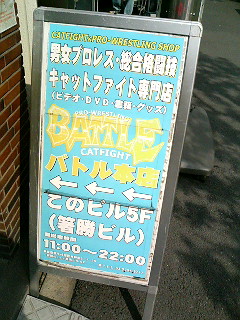 Battle: 千代田区外神田3-1-15はしかつ本店ビル5F.
Battle: 千代田区外神田3-1-15はしかつ本店ビル5F.5th Floor Hashikatsu Honten Building, 3-1-15 Soto Kanda, Chiyoda Ward, Tokyo.
Time to time in Akihabara you come across something truly bizarre, truly hentai (perverted). Battle is one of these places. The sign in the photo here says "Battle Catfight -- men & women pro wrestling". Battle proclaims itself to be a Pro Wrestling Shop, but there is much more to the place than that. As Harmful, a man well acquainted with the seedier sides of Tokyo, reported: "Another one of those find-the-tiny-folding-sign-and-go-in-the-anonymous-looking-doorway-and-up-the-elevator deals. Battle is on the 5th floor.but -- lucky you! it is sandwiched between 2 other fetish stores! on the 4th is SPORTS FETISH store, where you can get videos of naked volleyball and pictures of old gym shorts, and 6th floor is FETISH WORLD.
FETISH WORLD is sort of a grab-bag of weird-for-the-sake-of-weird depravity, with a general focus on feet and trampling..."
Battle is open from 11am to 10pm.
Brainstown: 千代田区外神田???大竹ビル3F.
3rd Floor Ohtake Building, ?-?-? Soto Kanda, Chiyoda Ward, Tokyo.
Phone: (03) 5298 2499.
When I was just a newbie in Japan, Cheap Bastard was trawling the backstreets of Akihabara, searching for buried treasure. A couple of years ago he encountered a specialist comics shop called Brainstown, somewhere off Chuo-Dori. I haven't managed to find it myself, but this is how the Bastard described this scene: "Take the stairs up to the 2nd floor, where they sell regular and hentai manga and magazines. Going up to the 3rd floor, they sell doujinshi, doujinshi soft, doujinshi goods, some live-action porn, and some other hentai anime-type shit. It's all retail price."
 Doll@Cafe: 千代田区外神田1-6-7秋葉原センタービル5F.
Doll@Cafe: 千代田区外神田1-6-7秋葉原センタービル5F.5th Floor Akihabara Center, 1-6-7 Soto Kanda, Chiyoda Ward, Tokyo.
Phone: (03) 3251 5865. Web: web.archive.org/web/20060415002716/http://www.doll-cafe.net/.
Waiting for a train last weekend I noticed a new billboard at Akihabara Station (Hibiya Line), at the southern end of the northbound platform. On first glimpse I thought it was spruiking a new maid cafe, or a place where the waitresses dress up as anime stars, etc. But no, that would be too pedestrian, too mundane. The billboard was in fact advertising a hentai-themed hotel (I suppose we could call it a "brothel", but I might get banned for using such a term). The story gets even kinkier: it turns out that none of the hostesses/prostitutes at this "cafe" are real. They are, wait for it... dolls! You could say that this is a dollhouse for grown-ups, for men who like playing with dolls. I admit, some of them look cute -- see some pictures here. But for the life of me I just can't understand why people would shell out money -- and this case a lot of money -- to sleep with a doll. For that amount of money they could purchase a real hooker.
Like love hotels, there are two options -- the short stay (euphemistically called a "rest"), and the "night course".
It's cool to take photos of yourself with the dolls, and you can also dress them up in whatever turns you on -- school uniforms and maid costumes seem to be particularly popular (this being Akihabara and all!)
The dolls are specifically made for love, weigh in at around 26 to 28 kilograms, and are 140cm to 150cm tall when standing. A night of passion with one of them will set you back 22,000 Yen (around US$250). If you want a quick rumble then a 45 minute session will cost you only 10,000 Yen.
 Lammtarra: 千代田区外神田4-3-2.
Lammtarra: 千代田区外神田4-3-2.4-3-2 Soto Kanda, Chiyoda Ward, Tokyo.
Phone: (03) 5209 4088.
This bright orange bazaar occupies a sliver of Chuo Dori streetside between LAOX and Sega, near Akihabara Station. Not only is the building narrow, but the aisles are very restricted as well. There is not much room, because it is stuffed with pr0n, anime pr0n -- adult videos or AVs as they call them in Japan.
I personally find this an interesting store, though I am no hentai (my girlfriend might disagree!) As you head up the stairs (which are narrow, like everything else in the complex) the vidoes and DVDs become progressively more hardcore. On the first and second floors it is fairly innocent enough -- cute girls in school uniforms or maid outfits, a lot of lesbian action, tongues interlocking, bodies erupting in wild passion... The stairs go on, ever up. By the time you stumble out on to the fifth floor, things have gone too far, as far as I am concerned -- bestiality, girls chained up with the dogs, sex in the stables, and that sort of thing are the order of the day. Amusingly, the customers look respectable enough -- salarymen on their lunch break and young students. Ahhhh... such is the paradox of Japan. Innocent but yet kinky -- and they don't even know how kinky they are. That's why I love this country!
If you make it to the roof, there is a maid cafe called Lamm Maid Café, which you can read about here. I never got that far.
 Miharu: http://web.archive.org/web/20060112072914/http://miharu.ciao.jp/.
Miharu: http://web.archive.org/web/20060112072914/http://miharu.ciao.jp/.If you want to get emails from a guy pretending to be a girl pretending to be your girlfriend, jon this site. Miharu is in fact a fictional "Akihiaba style idol", and she is often dressed in a school uniform. Basically the idea is you give Miharu your cellphone address and she will send you childish but rauncy and suggestive emails (I am not sure foreign email addresses are okay -- you might as well give it a try!) There's a guy in Liberty House who claims that he used to work in such a company, pretending to be a woman. Therefore Miharu wouldn't do it for me because I know how this particular magic trick works. If you one of those people who can suspend disbelief, you might get turned on by Miharu. If you are in Tokyo you might also catch her in public -- I saw two of her at Harajuku today, dressed in her famous maid costume (see the picture above!)
Monday, April 10, 2006
Skogar Treks (Iceland)
 |
| Seljalandsfoss, just off the ring road near Skogar in south Iceland. |
Danny wrote of his trekking experience:
The morning was bright and clear. "Fossbuin" was closed, so we could neither shower nor pay for the campsite. We packed everything ready for our hike, but then went to check out the Skógar Folk Museum. This consists of a number of buildings: old farmhouses, many of them with turf walls, a reconstructed church and schoolhouse, a large modern building housing the folk exhibits, and a brand new Technology and Transport Museum. Þordur Tomasson, the curator who inspired the museum, is still going strong, and he performed for us on one of the little organs, singing along, and on a dulcimer.After checking out the museum and the amazing houses with grass growing on their roofs (just like the Hobbit Holes in The Shire!), Danny and his team trekked on to Þórsmörk. This is actually a short trek by Skógar standards -- the standard walk is a whopping 70+km long, up to Landmanalaugar (although people usually follow the route in reverse, from Landmanalaugar down to Skógar, possibly because it is easier as it is mostly downhill.) If you are interested in reading the accounts of some trekkers who have taken on this trek and won, visit these following sites (eds. note: these are so old they are in the archives now!):
A good web-blog from the days when web-blogs didn't even exist. This site will give you a good introduction to travel in Iceland, especially if you of the pennypinching disposition. But first, allow me to get an anti-Semitic rant off my chest: If you have ever been to Thailand or India you will have probably come across Israeli backpackers and been shocked by their aggressive bargaining tactics. It seems that Israelis have an almost allergic reaction to spending money while they are on holiday, and they will do anything -- anything -- to avoid coughing up the cash. I have even seen them bargaining in fixed price places like Kodak film development clinics (Bangkok), provoking the wrath of both fellow customers and staff. Some restaurants and hotels in Thailand and the subcontinent now refuse to admit Israeli customers for this reason -- to spare themselves the grief of a 3-hour argument about the bill. I haven't seen any "No Israelis Allowed" signs in Iceland yet, but they could start appearing, if the frigid island attracts more visitors of the ilk of Nir Halman.
If you ever wondered what goes on in the mind of an Israeli backpacker, check out Nir's site. This is one of the older Iceland adventure blogs on the Net -- it dates from 2001, and describes a visit Nir and his girlfriend made to Iceland in 1999. I enjoyed reading about how they try to save money by eating in supermarkets or BBQing their meals outside -- I should add that there is a bit of Nir in me, the last time I went to Iceland I was so short of money I was forced to sleep at the airport and hitch a ride to Blue Lagoon. One of the cool things Nir and his girl manage to do while in Iceland, is make the Landmannalaugar to Skógar trek. As Nir writes:
This trek is considered the best (but also the most difficult) in Iceland. It starts in Landmannalaugar, the site of a rather big hot water spring at an altitude of 600m. It is a remote and exposed place in the highlands bordering a big lava field from which Hekla volcano can be seen. This place is obviously popular with the tourists who visit it during the summer time. In the winter time, when a thick layer of snow covers the surroundings, it is left alone for the locals, who come to bath naked in the hot springs. The trek to Skogar is 70km long, and usually takes a week to walk. It is considered unique in the world as it passes through lava fields, volcanoes, hot springs, geysers as well as genuine alpine scenery of eternal glaciers, a high snow-covered mountain-pass and numerous snow fields.The other great thing about this trek is that the route is lined with well maintained and cozy huts where hikers can stay the night. Payment for accommodation at these huts is, well, optional. And you can assume that your typical Israeli, passing through this beautiful part of the world, will option out of paying if payment is only optional. The loyalty system doesn't work for every nationality, I am afraid. Nir's website is proof of that. One of the classic parts of Nir's adventure happens when they come across a group of Icelandic folks having a BBQ at a popular mushroom picking place en route:
They are eating huge amounts of BBQ meat and freshly grilled potatoes while we eat pasta and mashed potatoes made out of dried potatoes powder. We look at them with eager eyes and then with surprise when we see the amount of leftovers they throw in the garbage cans. We don't understand why they ignore us. They are so many and we are only 4 "poor" tourists. They could have offered us some of their food... Only when they see our mashed potatoes powder they start to talk with us, and offer to us the remaining 3 pieces of the cake that they have eaten. What a pity they didn't talk with us before and offered to us the meat...I too know what it is like to be a poor tourist in Iceland, forced to subsist on packets of dry noodles from Japan and cans of Asahi Blue, and tins of sardines and old bread. Next time I go to Iceland (June this year) things will be different -- I am going to live like a King. Lamb and roast pork and hotdogs for me every day -- I can hardly wait. Bring on the adventure!
Rowan Castle's Landmanalaugar to Skogar Trek
This route is rated as Iceland's premier walk, and some guidebooks even claim that it is one of the best treks in the World! It starts in the South Central Highlands, amongst the colourful rhyolitic mountains and geothermal vents of Landmanalaugar. These mountains were laid down by volcanic action, and then dramatically eroded to create undulating hills of multi-coloured mineral deposits. As the path loses altitude, it descends out of these hills and crosses a bleak lava desert of black ash, punctuated by pyramidal mountains and raging glacial rivers. At the other side is the wide valley of Thorsmork (Woods of Thor), which has stunning views of two of Icelands huge ice caps - Eyafjallajokul and Myrdalsjokul. The route then climbs out of the valley, along a sharp ridge and crosses the Fimmvorthuhals Pass between the two ice caps. From there, it descends sharply to the North Atlantic coast, finishing at the sixty metre high Skogafoss waterfall at the small settlement of Skogar.Castle describes the long trek from Landmanalaugar to Skógar in gruelling prose, with blocks of text interspersed by links to his photo gallery. I liked some of the little incidental touches, like the discovery of some little Arctic flowers in a crevice somewhere, their fragile beauty contrasted against the massive glacier stretching for miles and miles into the distance -- the microcosm within the macrocosm. Castle described some mud he had found on his trek thus: "a stream at the bottom (of the ravine) emerged from a perfectly formed tunnel under the ice, but the stream had deposited strange bright orange mineral deposits onto the black ash. The contrasting colours of orange, white and black looked like they belonged to an alien landscape."
That's why I love Iceland -- I just can't get enough of those alien landscapes! And if you want to plunge yourself into one alien landscape after another, go read Rowan Castle's site. Even if it doesn't formally exist any longer!
Wednesday, January 11, 2006
Making Mochi, and Appeasing the Gods (New Year in Shikoku)
My newly adopted grandmother and grandfather are certainly old school in how they live -- they're up every day at 4am to do all the chores that need to be done, like picking vegetables or making presentations to the gods which live all around their country house. I decided to emulate them while I was on their island, for a couple of days at least. Well, I knew I would never be able to get up at 4am, but I wanted to enjoy all the clean-living fun of rural Japan -- working in the fields, taking the dog for a walk in the bamboo thickets, drinking warm sake under the warm warm kotatsu. On my first full day in Shikoku, I was able to participate in another chore, a particularly sacred one -- the making of mochi rice cakes.
Before we go on, I ought to explain... what are mochi rice cakes, exactly, and what do they mean to the Japanese people? Let's go to one of the popular sources of modern times: Wikipedia! Wikipedia says: "Mochi (Japanese 餅) is the Japanese variant of Chinese rice cake, which, like its Chinese origin, is made of glutinous rice, pounded into paste and molded into shape; however, unlike the Chinese variety, it is molded right after it is pounded, whereas the Chinese variety is baked once again after to solidify the mixture as well as sanitize it. Traditionally in Japan, it is made in a ceremony called mochitsuki. It may also be made in an automatic mochi machine, similar to a breadmaker. In Korea, a nearly identical food is called duk (also spelled dduk, duek, d'uk, or tteok)." (Ed's note: those Koreans have a knack of giving the same basic food a million different names -- see my Korean Dog Soup Page for more comfirmation of this!)
On the subject of Mochitsuki, which is the ceremony I was blessed to participate in, Wikipedia continues: "Polished glutinous rice is soaked overnight and cooked (eds note: see first picture in the series below: the rice is being steamed in a traditional mushiki here.) The rice is pounded with wooden mallets (kine) in a traditional mortar (usu). Two people will alternate the work, one pounding and the other turning and wetting the mochi. The mochi must be kept wet to keep it from sticking to the mallet. The sticky mass is then formed into various shapes (usually a sphere or cube)."


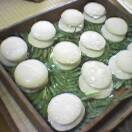
That's making mochi in a nutshell: a lot of steaming, a lot of pounding, and a lot of kneading into the desired usually moon-like shape. What you end up with a lump of soft, sticky, gooey, glutinous goodness. They taste somewhat bland perhaps, although you can spice them up coating them with various substances, or stuffing them with red bean paste or even ice cream (that last item is not particularly old school though!) In the photo block beneath you can see another variant being made -- grass mochi! Kusa mochi (Japanese: 草餅), also known as yomogi mochi, is a Japanese sweet, and despite the name is made not from grass but rather mugwort.


Yes sirree, the Japanese love cooking and eating these rice cakes at New Years Eve, although they are often eaten elsewhere in the year. Japanese also love presenting the mochi to the gods, to thank and honor them and to ensure good fortune in the following year. It is interesting that throughout human history, all over the world people have felt compelled to offer sacrifices to the Higher Beings, in order to win their appeasement and their approval. I was reading Homer's The Odyssey last year, and what impressed me the most, apart from the brutality of the climax, was how on almost every second page one of the heroes burnt up a pile of bovine thigh bones, or a rack of juicy steaks, to satisfy Zeus and his ilk. Now they don't practice animal sacrifice in Japan, but they do have plenty of reverence for the gods -- and there are literally millions of gods in this country. They don't sacrifice animals, but they do sacrifice food, which must have meant a big loss of resources back in the old days when there were a lot of hungry mouths to feed.
One thing I ought to point out right here is that New Years Day is celebrated in a completely different way in the East than it is in the West. In Japan/Korea/China/Vietnam New Years Eve/Day is kind of similar to the western idea of Christmas in that it is a day for family get-togethers, quiet reflection and acts of religious devotion, the consumption of vast quantities of food, dozing off in armchairs, getting up late and basically taking it easily. Ironically, Christmas Eve is the time to party in Japan, and many couples ask each other out on dates on this day; going to Kentucky Fried Chicken is especially popular. Go figure! So in other words, the Japanese New Year is our Christmas, and our New Year is their Christmas, in a manner of speaking! One of the things Japanese people do on New Years Day, apart from eating and drinking a lot of substances themselves, is that they make offering to the gods. At the home of my adopted family in Shikoku, they honor and partake in a particular tradition, which I call making mochi trees. Actually, it is only one tree they make, a small typically Japanese bonsai style fake tree, basically a stick skeleton hung with colorful shiny baubles and -- get this -- little pieces of mochi, rolled up to make what are called mochibana (rice cake flowers). The little stick tree is then propped up in front of the household altar, in the belief that the gods will come and eat the flour flowers, while the humans are off enjoying themselves devouring osechi ryori and sinking sake elsewhere in the house.


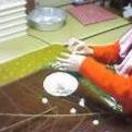
In the photo bar above, you can see mochibana being applied to the branches of the fake tree, by my girl C. In the photo bar beneath, you can see the mochi tree in all its colorful glory, before the household altar. The final photos display more substantial fare for the gods -- a full tray of shrinkwrapped rice cakes ready for Divine Degustation. There are also some dried kaki (persimmon) and a whole salted fish, if any spiritual beings take a fancy to that.

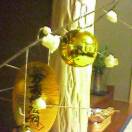
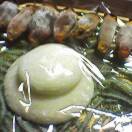
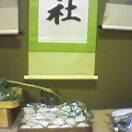
The idea of leaving fish and dried foods on an altar in your house for invisible beings to eat might seem strange to us westerners, but we do have some similar practices of our own. In a lot of countries people leave out glasses of warm milk (or cold beer, in Australia) for Santa Claus to drink on his annual visit, and there is a carrot in every house for the Easter Bunny. In some countries, children who have lost teeth put them in a glass of water beside their bed, and in the morning they are transformed into money! Perhaps Santa and the Easter Bunny and the Tooth Fairy are all we left of our pagan animist past. In Japan in the animist past lives on. In Japan animism never died.
Like many other things in Japan, mochi plays a spiritual role in life. Every village or town has its own special ways of using it in its religious rites and customs. In the small town of Aratano (Tokushima Prefecture) in Shikoku, for example, a festival is celebrated in the early New Year called Mochi Nage, or "Thrown Mochi". The idea behind Mochi Nage is disarmingly simple: people turn up at the local Shinto shrine, some shrine workers come out with bags of cooked (and I assume blessed) rice cakes, wrapped in plastic for hygiene, and proceed to hurl them at the assembled crowds. Little kids dash about, catching or picking up as many of the rice cakes as they can bundle into their arms. Old ladies push younger countrymen/women aside in the mad melee. Perhaps some fire works are discharged. At the Mochi Nage festival I attended at Aratano, I got pelted by a couple of the thrown cakes, which are actually quite hard and could easily "take an eye out", if you were hit the right way. I also managed to collect a big bag full of mochi, and this bag was eyed enviously by some of the local kids in attendance there. The gods were on my side; I managed to do a good job.

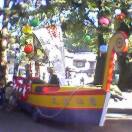
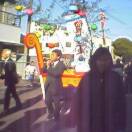
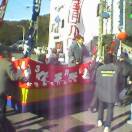
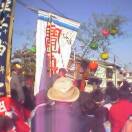
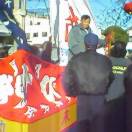
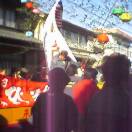

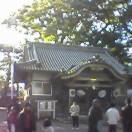
In the photo bar above, you can see photos from the Mochi Nage festivities at Aratano. In this town's version of Mochi Nage, a colorful boat-like vehicle (actually a converted car) is first rolled through the streets, attracting a crowd of eager scavengers. Like a Pied Piper, the car led us on to the local shrine where the proper rice cake chucking and catching sessions began -- and as I already mentioned, I ended up scooping up much of the venerable little goodies (attribute that to luck, or perhaps to favor of the mochi gods!)
Whether we be human or animal or vegetable or god, all we want is the same thing in life: recognition for our existence and our efforts, and perhaps a bit of love and respect served on the top. That is what mochi encapsulates, and celebrates: the awareness that life is a ritual in which everyone must play their part, and in which every part is glorious. Witness the life cycle of this critter: pounded out of generous grains nurtured by the Four Elements, molded into moon shapes, then offered to the local deities, or tossed to little kids and grandmothers at the shrine... isn't this all just a celebration of the earth, a celebration of what the Earth can offer? We take from the earth and give back to it, and then it gives back to us, etc. The cycle keeps on repeating, endlessly. Creating abundance out of scarcity, rebirth out of decay, a New Year from the Old. The cycle never ends. The gods of Shikoku taught me all this, and more. In time, I might teach them a thing or two! In a couple of lifetimes or so.

